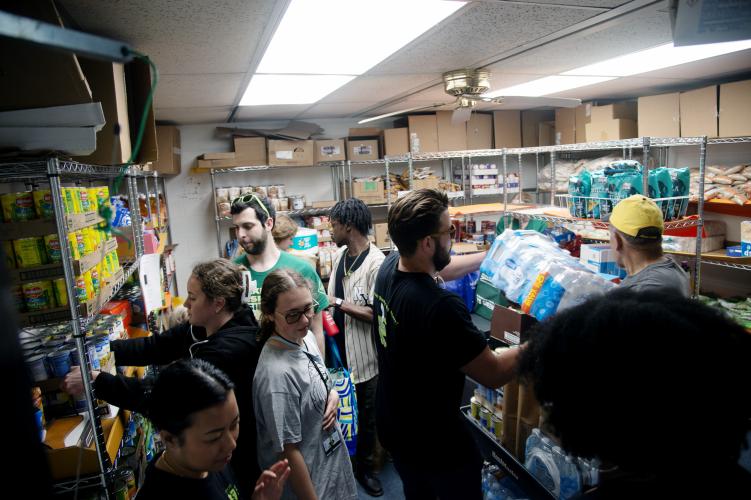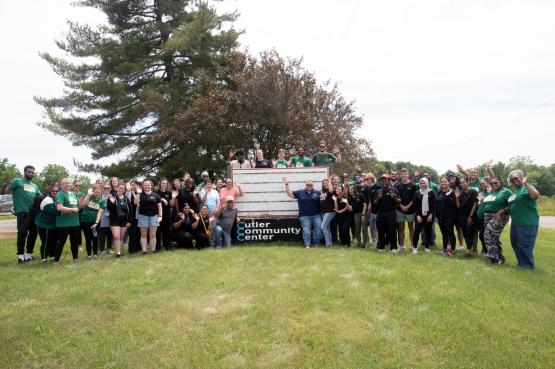
Regional tour gives prospective medical students close look at Southeast Ohio health care

Students from the Summer Scholars and Pre-Matriculation programs at Ohio University’s Heritage College of Osteopathic Medicine had the opportunity in June to learn about the unique challenges of rural health care and the diverse history of the region thanks to a group tour of southeast Ohio.
The tour began in Chesterhill, Ohio, where students visited the Multicultural Genealogical Center, the local Quaker Meeting Room and Henman’s Cave. They learned how Chesterhill played an important role in the Underground Railroad and saw the places where enslaved people were hidden while they escaped to freedom in Canada.
One student on the tour, Bethany Owoeye, of Dayton, Ohio, said she appreciated learning about the area’s involvement in the Underground Railroad as an adult.
“I think this was a great aspect of the program. I think a lot of the information that I had about history, being African American, specifically being African American in Ohio, came from my primary education and I feel like at that time I didn’t understand fully what I was learning. As I get older and I kind of learn what it would mean to take care of my people I want to make sure I understand the history very well,” Owoeye said.

Owoeye was part of the Pre-Matriculation Program, a four-week accelerated introduction to medical school for students in the summer before their first year at the Heritage College. The program is held each year on the Athens campus and allows students to gain insight into the content and rigor of the first semester of the Pathways to Health and Wellness curriculum. They are introduced to effective study strategies, as well as the basic scientific concepts that will form the foundation of their clinical education.
Students from the Summer Scholars program represented the other half of the students on the tour. The Summer Scholars program is designed for aspiring physicians from communities experiencing health care disparities or medical provider shortages. The five-week program gives participants a realistic introduction to the first-year curriculum at the Heritage College. There are also workshops on the admissions process, learning strategies, time management and other areas relevant to medical school experience.
Students from both summer programs are also granted opportunities to become familiar with the health care disparities and social determinants of health endemic to Southeast Ohio through planned outings like the regional tour.
After leaving Chesterhill, the students on the tour visited Cutler, Ohio, a once-thriving community that has dwindled in population and resources as extraction industry jobs left the area. They met at the Cutler Community Center, one of the few public buildings in town, which serves as a library, meeting place and community food pantry. Students were able to listen and take part in a discussion with residents about the diverse history of Cutler and how the area’s lack of health care resources impacts them.
Amanda Flowers, Ph.D., led the discussion, speaking to the students about growing up as a Black person in Cutler. She explained that many people look at rural areas and incorrectly assume that everyone is white. She shared that some people experience a sort of double discrimination for being both Black and Appalachian from physicians in larger cities who are not representative of their own community. This is reflective of research findings that show that Black patients may have better health outcomes when they are treated by a Black physician.
The discussion was of particular interest to Owoeye, whose family moved here from Nigeria.
“Being immigrants, it’s like a lifelong learning process of what people like us have gone through here. So, I want to make sure that I have that foundation first before I start going out into the community to offer help,” Owoeye said.
Fellow Pre-Matriculation student Jacob Kilmer, of Portsmouth, Ohio, also hopes to return to his hometown after medical school. Kilmer was born with a heart defect, causing him to need open heart surgery at only two weeks old. He has seen a cardiologist every year since, and it has inspired him to pursue a career in cardiology. He says the discussions in Cutler cemented the idea in his mind.
“I’ve always wanted to serve my community and there is a need for cardiologists there. So, seeing this just further resonated with me that communities like this need people to come back,” Kilmer said.
Discrimination isn’t the only thing that impacts health outcomes in rural communities. Flowers also discussed the lack of infrastructure like public transportation in areas like Cutler, where the nearest hospital is at least a 45-minute drive away, a fact that can be life-threatening in emergencies.
“A lot of people don’t have vehicles, and there’s some people that have vehicles but don’t want to drive a far distance. It can be overwhelming, especially when you don’t feel very good,” Flowers said.
The lack of resources in Cutler also includes grocery stores, as the community is a food desert, as it does not have a grocery store with access to fresh healthy food, making the food pantry at the Cutler Community Center a vital resource. The summer programs students delivered non-perishable food items, toiletries and water that were donated by the Heritage College community across all three of its campuses.
Kenny Cunningham, director of the food pantry, says that approximately 50 families rely on it.
“This means a lot because it’s hard to get food. This food, it’s a blessing,” Cunningham said.
“Our donation to the Cutler Community Center’s food pantry was a physical demonstration of what ‘Care Lives Here’ looks like,’” said Kelly Davidson, former assistant director with the Heritage College Office of Inclusion and current associate director of Diverse Alumni Initiatives. Davidson, who coordinated the regional tour, added it was beneficial for both the food pantry and the students.
“The mini tour of Southeast Ohio was created to expose the participants of HCOM’s summer programs to the realities associated with living in and practicing medicine in the Appalachian regions in Ohio. I wanted the students to not only hear about the health care disparities in this region, but I also wanted them to actually see what the region looks like, up close and personal,” said Davidson. “I wanted the students to see the beauty of the region and to hear about the rich diversity within Ohio’s Appalachian region from physicians who practice in the area and from individuals who were born and bred in this region.”
